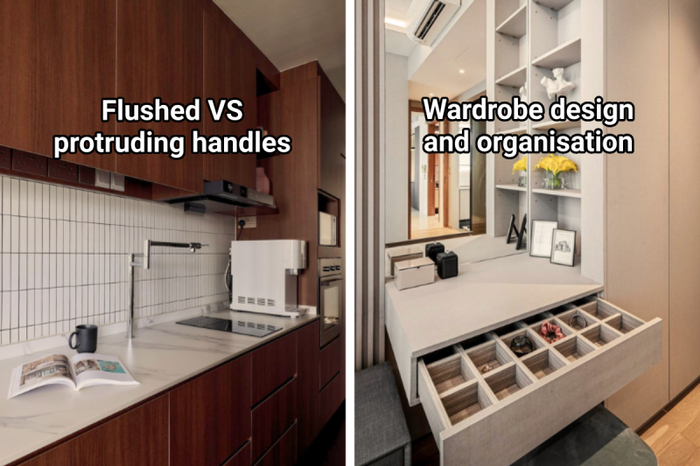And you don’t want to miss a single one.
While style and budget tend to be the biggest concerns for a home renovation, don’t forget to pay equal attention to the smaller details that contribute to the home’s comfort.
From subtle design details that will affect the interior’s overall look to functional aspects that can greatly improve usability, be sure to take note of these oft-overlooked details to ensure that your dream home looks and feels exactly as you intended.

Door handles/knobs
Thinking of getting recessed or flushed door handle designs for a sleek cabinet finish? It’s a great aesthetic choice, but do test the handles to ensure that the grip is comfortable since you’ll be using them daily.
On the other hand, for those with joint problems like arthritis, it’s best to choose non-flushed handles/knobs. For these, try levered designs if you usually have your hands full or you prefer handles that have a bigger grip.

View this project by Third Paragraph
ABS trimming on carpentry joints
One thing to note is that not all built-ins come with ABS trimming, which is a method of concealing the joint lines between the edges of two surfaces. These make laminates, for example, look seamless when installed on a fixture and help them last longer too.
When you’re choosing laminates, be sure to check with your interior designer or contractor on this.
While these edgings may come at a small additional cost, it's best to include them for all the exposed built-ins around your home, including high-usage areas such as doors and cabinets, for long-lasting laminates.

View this project by Ofthebox
Cabinet door closing system
One cabinet feature that’s worth considering is soft-close hinges; in heavily-used spaces like the kitchen or in the kids’ bedroom, it’s simply much more pleasant handling doors and drawers that close smoothly and quietly no matter how hard you slam them shut!
They’re also much safer for kids since their fingers won’t get caught when the doors close gradually.
Apart from that, this mechanism helps to reduce cabinet wear-and-tear; no doors slammed means there’s less stress on the cabinetry and its components.

View this project by The Interior Lab
Wardrobe organisation
To make the most of your wardrobe, customise the internal space to suit your needs: plan how much space you need to devote to each section in order to get the right dimensions to cater to your clothes.

View this project by Todz’Terior
For instance, if you have plenty of long dresses, allocate more full-height hanging space for it. Or, if you have lots of folded clothes, opt for drawers over cubbyholes.
Incorporating space-efficient wardrobe accessories such as pull-out trays, dividers, and valet hangers can also help you stay organised.

View this project by Mr Shopper Studio
And if your wardrobe is in a darker corner of the room, consider having lights built into the cabinets to better illuminate the cabinet interior.

View this project by Starry Homestead
Kitchen countertop height
It’s easy to settle for the default kitchen countertop height, but depending on your height and/or if you have mobility restrictions, working at such a height would be uncomfortable during meal prep and turn into a pricey regret.

View this project by Ethan Interiors
Consult your interior designer on what the suitable countertop height is for you for better ergonomics, especially taking into consideration other household members who might have a significant height difference.
For instance, you could cater the countertop height to the family member who cooks the most, or to the shorter/taller individual depending on your preference.
Another option is to have differing countertop heights, like regular-height counters and a higher island.
Direction of wood grains
Beyond its hue, the grain patterns of wood also play a subtle role in achieving different looks. Straight grains are great for a calming and minimalist look, while irregular grain directions like diagonals and spirals are more arresting and therefore evoke a more contemporary feel.

View this project by Fifth Avenue Interior

View this project by ELPIS Interior Design
Lighting (cove and under-cabinet)
Lighting design has the ability to soften, enhance, and change the entire feel and functionality of a space at night.
Under-cabinet lighting ensures that shadows cast from overhead task lights don’t hinder your vision, while cove lighting elegantly softens the hard lines of cabinets, creating a welcoming and calming atmosphere.

View this project by Ovon Design

View this project by Editor Interior
Kitchen ventilation
If you cook often, you know how hot and sweaty it gets in the kitchen – especially with Singapore’s humid weather.
While keeping the windows and/or door open can help, you can consider getting a corner ceiling fan to improve the ventilation and cool the kitchen down.

View this project by Glamour Concept
An added bonus is that they fit even in tight spaces unlike traditional ceiling fans.
Cable management
One key point is to discuss with your interior designer is how you’d like to configure the power sockets in your home. Think about the number of power sockets you need, as well as the best locations to place them based on your habits and movement in each room.
Be sure to think this through this; getting an electrician to rewire your home after the renovation is completed involves additional costs and hassle.

View this project by Yang's Inspiration Design
Do your pet peeves include unsightly cables and power points around the home? You certainly aren’t alone in feeling that way.
Your interior designer can advise you on some ingenious ways to conceal them, from the wiring of entertainment sets to desktops and kitchen appliances.
Placement of Wi-Fi router
Unless you live in a completely open studio apartment, chances are that you’re losing some WiFi signals to the thick concrete walls around the home.
One way you can get the best connection anywhere in the home is to place the router as close to the centre of the home as possible, without any obstructions around it.
And while the router is rather unsightly, it's better not to hide it behind carpentry as it’ll slow down your WiFi connection.

View this project by Omni Design
Don’t miss a single detail for your home renovation
If you’re thinking of engaging an interior designer to help you spot all these tiny details, simply tell us your renovation requirements – like your budget and design preferences – and you’ll get free personalised renovation quotes from local interior design firms.
By doing so, you can also opt in for the $50,000 Qanvast Guarantee that safeguards your renovation deposits.
This article was originally published on 14 December 2017 and last updated on 26 March 2024.

 Get a budget estimate before meeting IDs
Get a budget estimate before meeting IDs